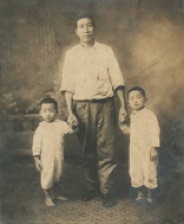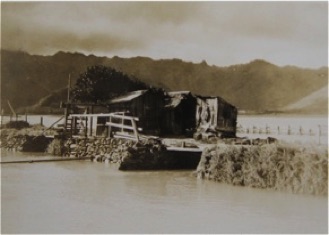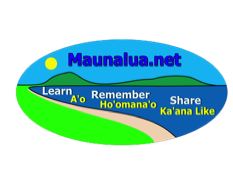Keahupua o Maunalua
Lit., Fishpond Wall
It was once believed that the pond was partly constructed by menehune
and was connected by a tunnel to Kaʻelepulu pond, Kailua.
(Pukui, Elbert, Moʻokini)
Kuapā Fishpond
Kuapā Fishpond was once the largest fishpond in the archipelago of Hawai’i.
It covered 523 acres.
According to Makea Napahi, the pond was built by Mahoe, her great-grandmother. When the pond had been only partially completed, the menehune came and in one night finished the construction.
At times when there was a dearth of fish, which Mahoe coped with in this manner. On the nights of Kane, she took a baby pig as it came from the womb of the mother, and had her small grandson carry the squealing animal about the pond. There was a strict tapu until the next night, which was the night of Lono. No fishing was permitted, and no noise allowed to disturbed the praying kahuna. On the night of Lono, seaweed and ilima were gathered and placed on the shrine. After the night of Lono, when this ceremony was apparently completed, there was plenty of fish.
McAllister
Archeology of O’ahu 1933
_____________________________________________________________________________
“We soon passed a village mostly inhabited by the fishermen, and containing one hundred huts.” (From Mathison -- “Narrative of a visit to Brazil, Chili, Peru, and the Sandwich Islands, 1821-1822)
The village he speaks of was probably on the Honolulu side of Kohelepelepe, at the head of the pond in Kamilonui valley. It may possibly have been the settlement at Hahaione valley, but I think that Mathison crossed on the seaward side of the pond, which caused him to notice merely an “Embankment of sand.”
McAllister
Archeology of O’ahu 1933
Keahupua-o-Maunalua Fishpond
(Coming from Makapu’u) . . . I descended with my attendant, and near the shores of a large pond containing a surface of many hundred acres, I came to a little settlement called Keawaawa and stopped a few moments to enquire the way and to allow my attendant the luxury of a whif of tobacco. Thence I walked on by the side of the pond in a southerly direction about a mile, having the eminences Maunalua on my left -- I then came to a narrow strip of land resembling a causeway partly natural and partly constructed extending in a North wet direction across what appeared to be considerable of a bay forming a barrier between the sea and the pond. At the further end of this causeway sluices are constructed and the waters of the sea untie with the pond an dat every flood tide replenish it with a fresh supply of water. Near the middle of this causeway there is a settlement of 18 houses belonging to Kalola called Maunalua. Here I stopped about an hour . . . rested myself, took some refreshment and read the kanawai. -- At 5 minutes after 12 I set out again and after walking about 3 hours passing through 3 settlements and reading the kanawai . . . I arrived
at the school house in Waialae.
Levi Chamberlain
Trip Around O’ahu in 1826
The pond is said to connect by means of an underground tunnel with Kaelepulu pond in Kailua. From time to time great schools of mullet disappear from the Maunalua pond and are to be found in the Kailua pond. At the same time the awa which were in the Kailua pond appear in the Maunalua pond. When the mullet reappear in the Maunalua pond the awa disappear. Kanae, the fish warden, tells me that this occurs even today, but cannot be explained by the Japanese who leases the pond.
McAllister
Archeology of O’ahu 1933
Lau-kapu dwelt in the ponds of Maunalua near Koko Head. (She was a mo’o.) She cared
for the fish for the life of her high chief and his people.
Westervelt
The Hawaiian Dragons
Paradise of the Pacific Jan. 1920, p11
Oua was the offspring of a mano and mo’o. He was the sweetheart of Mamala. When she left him for Hon-ka-’upu, he went home to Kuapa.
Pukui, August 4, 1953
Hawaiian Historian Kamakau writes of Kamehameha the 1st participating in the restoration of the Maunalua fishpond.
. . . encouraged the chiefs and commoners to raise food and he went fishing and would work himself at carrying rock or timber . . . He worked at the fishponds at Ka-wai-nui,
Ka’ele-pulu, Uko’a, Mauna-lua, and all about O’ahu. . . (Kamakau 1961:192)
Click on pic to learn about Tokio Jodoi aka Uncle Fishy whose family leased the pond in the 1920’s & 1930’s
Click on pic to learn about Joe Young whose family leased
the pond from the 1930’s to the 1940’s
Click on pic to view historical photos of Kuapā Pond
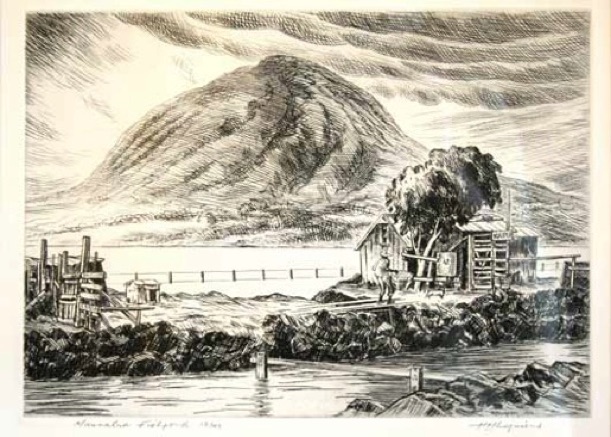
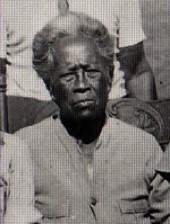
Makea

The traditional name of this fishpond is
Keahupua o Maunalua.
Art by Huc Luquiens
_____________________________________________________________________________
Kamehameha
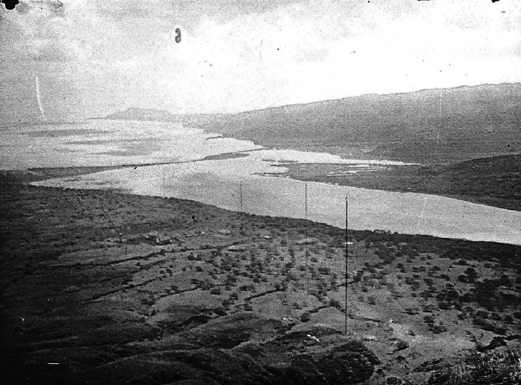
Keahupua o Maunalua 1915


_____________________________________________________________________________
_____________________________________________________________________________
_____________________________________________________________________________
_____________________________________________________________________________
_____________________________________________________________________________
